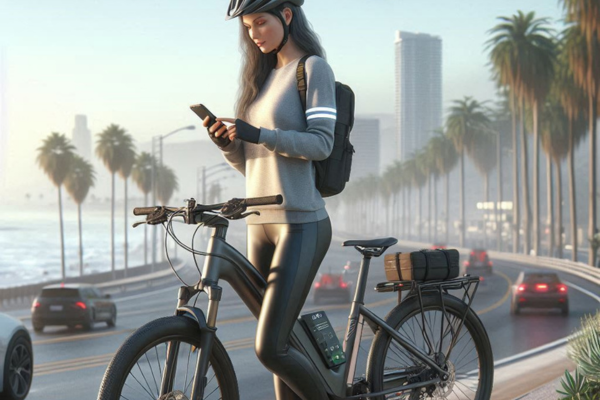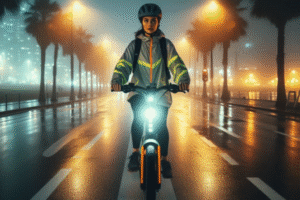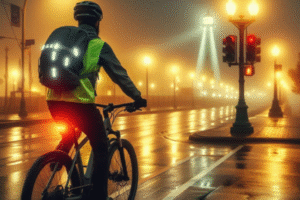📱 Coastal Commuter Tech: Best Safety Apps for E-Bike Riders in Rainy Urban Areas
Electric bicycles are transforming how we move through cities. They’re fast, eco-friendly, and empowering—but they also bring new safety challenges, especially in coastal environments where rain, humidity, and unpredictable traffic demand sharper awareness and smarter tools. For e-bike commuters navigating coastal cities like Miami, Santa Marta, or Cartagena, the smartphone becomes more than just a communication device—it’s a safety command center.
This guide explores the best mobile applications to enhance safety, visibility, navigation, and situational awareness for e-bike riders in humid urban climates. We go beyond standard maps and weather apps to deliver truly useful, commuter-tested digital solutions. Whether you’re dodging puddles at rush hour or trying to avoid unexpected tropical showers, these apps can help you ride safer and smarter—every single day.
🌧️ Why Coastal Urban E-Biking Demands Smarter Safety Tools
Inland commuters face their share of dangers, but coastal cities come with unique risks that elevate the importance of mobile assistance. Sudden rainfall can reduce visibility to a few meters. High humidity can fog up glasses, helmets, or even phone screens. Congested waterfront routes and inconsistent lighting conditions complicate navigation further. And in some areas, drainage issues turn bike lanes into small rivers in minutes.
Smartphone apps can mitigate many of these hazards by giving riders access to real-time weather alerts, route planning, visibility optimization, emergency response contacts, and even social riding networks. But not all apps are created equal—and few are designed with coastal realities in mind. That’s why this guide focuses on apps that are especially valuable when riding through sea mist, over wet pavement, and around tourists with umbrellas.
🧠 A Real Story: Diego’s Morning Ride in Barranquilla
Diego, a university student in Barranquilla, commutes 6 km daily to campus. One rainy Tuesday morning, his usual route through the Malecón del Río was partially flooded due to overnight rain. Using a route-planning app with flood alerts, Diego quickly rerouted through safer streets. “If I hadn’t checked the app, I would’ve ended up ankle-deep and probably late,” he said. His story shows how a simple app update can prevent not only discomfort, but real safety hazards.
📲 What to Look For in a Safety App for Coastal E-Biking
Before we jump into specific recommendations in the next block, it’s important to understand what features actually matter for riders like you—riders who face unique environmental challenges daily. Here’s a checklist to evaluate whether an app is worth downloading:
- ✔️ Real-time weather alerts specific to microclimates
- ✔️ Map updates for flooded or high-risk roads
- ✔️ Battery-efficient GPS tracking for long commutes
- ✔️ Hands-free or voice-activated navigation
- ✔️ SOS features or emergency contact integration
- ✔️ Compatible with bike-mounted displays or smartwatches
- ✔️ Light/dark display mode for night rides
- ✔️ Low data consumption modes for poor signal zones
🚴♀️ Tech as a Safety Companion, Not a Distraction
Some riders resist using mobile apps because they fear they’ll be distracted on the road—and that’s a valid concern. The goal isn’t to scroll while riding, but to prepare before the journey and have real-time assistance when needed. With proper mounts, voice prompts, and minimalist displays, your phone becomes a second set of eyes, not a source of noise.
“Smartphones don’t just connect you—they protect you. In coastal rides, they can see the storm before you do.” 📱🌧️🚲
In the next blocks, we’ll explore the top-rated safety apps across categories like navigation, visibility, weather, and community. Each one has been carefully selected to help you ride stronger, see clearer, and arrive safely—especially when the clouds start to gather.
📲 Top Safety Apps for Coastal E-Bike Riders
Not all safety apps are created equal—especially when you’re riding in coastal environments where salt, rain, and fog change the rules. In this block, we’ll explore a curated selection of mobile applications divided by purpose: navigation, weather, visibility, emergency contact, and community. Each app listed here has features that make it especially valuable for coastal commuters navigating humidity, inconsistent infrastructure, and sudden weather changes.
🧭 Navigation and Route Planning
- Komoot: Offers voice-guided cycling routes, custom trip planning, and terrain-based suggestions. Great for avoiding flood-prone areas and identifying bike-friendly streets.
- Google Maps (Cycling Mode): Reliable and widely used, now includes elevation, traffic density, and integration with bike lane data in many coastal cities.
- Bikemap: Ideal for longer commutes, this app lets you plan safer alternatives during storms and integrates with smartwatches for hands-free navigation.
🌦️ Real-Time Weather Apps
- RainViewer: One of the best radar-based precipitation apps, with hyper-local coastal rain tracking. Set alerts for sudden tropical storms or morning fog.
- Windy: Used by surfers, sailors and now—cyclists! Offers wind direction, cloud density, and humidity levels. Excellent for pre-ride planning in coastal zones.
- AccuWeather: A reliable favorite that offers daily rain probability and UV index, which can also affect road glare on wet pavement.
💡 Visibility and Illumination Tools
- Lumos App: Designed to control Lumos smart helmets. Allows you to manage turn signals, rear lights, and braking indicators—perfect for foggy evenings on the boardwalk.
- Beeline Velo 2: While hardware-based, the app that pairs with this minimalist display offers weather-adapted visibility data and vibration-based navigation.
- Light & Motion: Use this to monitor your smart bike light’s battery and brightness modes for optimal rain-night visibility.
🆘 Emergency and SOS Support
- Life360: Popular among families, this app allows loved ones to track your location in real time. Great for solo riders during storms.
- Road iD: A digital ID that sends your live location to emergency contacts during a ride. Can also work with Apple Watch or Garmin.
- bSafe: Includes a “Follow Me” mode and SOS button with audio/video streaming to chosen contacts during a breakdown or risky situation.
👥 Community and Group Riding
- Strava: More than a performance tracker, Strava’s local “heatmaps” help you find well-traveled, safer routes used by other cyclists.
- Ride with GPS: Allows community-based route sharing. In coastal cities, you can follow curated group rides that avoid risky zones like slippery boardwalks or poor drainage areas.
- Bike Citizens: Features data-backed cycling maps generated by real rider feedback. Available in select coastal metros like Barcelona and San Francisco.
📊 Comparison Table: Best App by Feature
| Need | Best App | Coastal Advantage |
|---|---|---|
| Flood-aware navigation | Komoot | Includes elevation + bike paths |
| Storm alerts | RainViewer | Hyper-local radar + alert system |
| Night visibility control | Lumos | Smart helmet integration |
| Live location sharing | Life360 | Realtime tracking + alerts |
| Route inspiration | Strava | Popular among experienced riders |
Now that we’ve explored the essential tools, the next block will walk you through how to use them in harmony—not just individually. We’ll focus on smart integrations, battery-saving tricks, and techniques for using these apps safely while on the move, especially in low-visibility or rainy conditions.
🔗 Smart App Integration for Safer E-Bike Commutes in Coastal Cities
Having the right safety apps on your phone is a great start—but using them effectively is where the real safety gains happen. For e-bike commuters in humid, rainy coastal areas, app overload, poor battery management, and unsafe phone usage can compromise the very benefits you’re aiming for. This section will guide you through smart integrations, device compatibility, usage tips, and safe practices that elevate your ride without adding risk or distraction.
🧠 The Golden Rule: Simplicity = Safety
You don’t need ten apps running simultaneously. In fact, that can do more harm than good—draining your battery, causing notification fatigue, and tempting mid-ride phone checks. Instead, choose 2–3 core safety apps (as suggested in Block 2) and integrate them with your hardware in a way that works with your riding habits—not against them.
📱 Hands-Free Setup for Safer Rides
- Use voice-guided navigation only: Set up your route before leaving and rely on voice prompts instead of visual ones.
- Invest in a waterproof phone mount: Position it at eye-level but avoid looking at it unless stopped.
- Pair with Bluetooth headphones or a helmet with built-in audio: Ideal for receiving weather updates or navigation cues safely.
- Activate “Do Not Disturb While Riding” mode: This keeps your screen focused only on ride-relevant functions.
🔋 Battery-Saving Strategies for Long Coastal Commutes
Riding through humid cities like Guayaquil or Cartagena often means longer ride times due to detours or storm-affected traffic. Your apps must last the whole journey. Here’s how to keep them running when you need them most:
- Lower screen brightness: Especially useful during cloudy or rainy days.
- Download maps offline: Apps like Komoot and Google Maps let you preload areas.
- Use energy-saving modes: Many apps offer lightweight versions that use fewer resources.
- Carry a waterproof power bank: This is essential in areas where rain can delay your ride.
🧩 Integration with Smart Devices
Today’s e-bike riders are integrating their mobile apps with devices that enhance safety without distraction. Here are examples of seamless integrations that can transform your ride:
- Smart helmets (e.g., Lumos): Integrated lights, turn signals, and brake indicators controlled by your phone.
- Handlebar-mounted displays: Devices like the Beeline Velo 2 give minimalist navigation feedback via vibration or arrows.
- Smartwatches: Great for receiving SOS alerts, heart-rate notifications, or simple nav prompts when your phone is stored.
🧠 Real Story: Mariela’s Rainy Ride Strategy
Mariela, an art teacher in Lima, uses RainViewer for planning and Komoot for her 9 km coastal commute. She connects both apps to her smartwatch and only mounts her phone on rainy days. “The key is knowing when to check your gear and when to just ride,” she says. “The apps are amazing, but they’re backup—not the ride itself.” Her strategy reflects the perfect blend of preparedness and presence.
📋 Pre-Ride Integration Checklist
- ✔ Route selected and saved offline
- ✔ Phone mounted securely with waterproof cover
- ✔ Bluetooth or helmet audio connected
- ✔ Rain and wind alerts turned on
- ✔ Power bank charged and packed
- ✔ Visibility gear synced (if smart-enabled)
“Smart riding isn’t about staring at screens—it’s about riding with a sixth sense, guided quietly by your tech.” 🚲📱🌧️
In Block 4, we’ll dive into what happens when things don’t go as planned—how to respond to breakdowns, storms, and emergencies using the apps you’ve prepared. Because visibility includes how quickly you can be found, supported, and guided to safety.
🆘 What to Do When Things Go Wrong: Emergency Responses with the Help of Safety Apps
Even the best-prepared coastal commuter can encounter an unexpected breakdown, sudden downpour, blocked route, or an accident. The reality of riding an e-bike in humid, rainy cities means learning how to respond calmly and efficiently when things don’t go according to plan. Fortunately, mobile safety apps can become powerful allies—not just in preventing danger, but in helping you manage it.
This block will show how to use your smartphone and integrated apps to navigate emergencies, make fast decisions, and stay visible and connected until you reach safety. These tools are not about fear—they’re about empowerment.
🚨 Step 1: Trigger Your Emergency App Features
- Activate live location sharing (e.g., Life360): Let trusted contacts know where you are. Essential when visibility drops or if you get separated from a group.
- Use “Follow Me” mode (e.g., bSafe): Perfect when riding through isolated boardwalks or during a storm. It automatically alerts contacts if you stop unexpectedly.
- Send a one-tap SOS signal: Apps like Road iD or bSafe allow you to send an emergency message with location and custom alerts in seconds.
💡 Pro Tip:
🔧 Step 2: Troubleshoot Tech and Mechanical Issues in the Rain
Sometimes the issue isn’t an accident—it’s your equipment. Rain and salt can create electrical glitches or mechanical failures mid-ride. Here’s what to do:
- Light or display not responding? Turn the device off, dry it with a microfiber cloth, and check for salt or moisture in USB ports or battery housings.
- GPS signal lost? Open your map app in offline mode or reset your phone’s GPS via airplane mode toggle.
- Battery dying fast? Switch off background apps and dim your screen; plug into your waterproof power bank if needed.
- Chain or brake issue? Use your maintenance checklist (if saved on a note app) or access a video tutorial through Ride with GPS or YouTube Premium (downloaded ahead of time).
🧠 Real Story: Javier’s Storm Survival in Guayaquil
Javier, a delivery rider in Guayaquil, was caught in a flash storm while commuting along a poorly lit highway. His visibility dropped, his rear light shorted, and his phone started lagging. He immediately used the Road iD app to notify his brother, switched to Komoot’s offline route, and rode to a nearby gas station. “Having prepped those apps ahead of time saved me from being stuck, invisible, and alone,” he shared. Javier’s story proves the importance of not just downloading, but mastering your tools.
📋 Emergency Response Checklist for Coastal Rides
- ✔ Pre-set emergency contacts in Life360, Road iD, or bSafe
- ✔ Keep voice commands enabled for hands-free alerts
- ✔ Save key troubleshooting videos or bike manuals offline
- ✔ Always carry a microfiber cloth, chain tool, and mini pump
- ✔ Know your nearest public shelter spots along your route (station, mall, café)
🔗 App Features That Double as Emergency Lifelines
| App Feature | Use Case | Why It Helps |
|---|---|---|
| Live tracking | Unexpected storm or isolation | Keeps someone updated on your ride status |
| Pre-saved offline maps | Signal lost in wet tunnels or remote paths | Ensures you always have guidance |
| One-tap SOS | Injury or blocked roads | Immediate communication without delay |
| Navigation rerouting | Flooded routes or traffic accidents | Keeps your ride efficient and safe |
“In a storm, your visibility may disappear—but your connection shouldn’t. Prepare your apps to guide you when sight fails.” 🌧️🆘📱
In the final block, we’ll wrap up with a powerful emotional close, your FAQs, and a message to inspire community among riders like you who brave the rain with tech, courage, and clarity.
❓ Coastal E-Bike Safety FAQs: Your Top Questions Answered
1. Do I really need all these apps just to ride in the rain?
Not all at once! Start with two or three that cover your most pressing needs—usually weather and navigation. As you get comfortable, explore others that enhance safety, visibility, or connectivity. The goal is to feel supported, not overwhelmed.
2. What if I’m riding in a small coastal town with poor signal?
Offline maps are your best friend. Apps like Komoot and RainViewer allow preloading routes and radar. Keep a power bank handy, and save your most-used emergency contacts locally. Don’t rely on Wi-Fi—plan as if you’re out of range.
3. Can I really trust my phone in a tropical downpour?
Only if it’s protected. Use a waterproof case or mount, and avoid charging in the rain unless absolutely necessary. Most modern phones have water resistance, but salt air and condensation are long-term threats—dry them after every ride.
4. What’s better—one all-in-one app or several focused ones?
Focused apps tend to be more reliable. One for routing, one for weather, and one for emergencies or community is a balanced setup. You want each to do its job well—not one that tries to do everything halfway.
5. How do I avoid distractions from notifications while riding?
Use “Do Not Disturb While Riding” mode or app-specific filters. Many apps allow you to mute all but ride-critical alerts. Also, consider voice prompts over screen interaction, and keep your phone locked on a dedicated dashboard view.
🤝 A Call to Coastal Riders: Make Visibility Collective
Every app you install, every habit you adopt, and every safety check you run makes you more visible, more confident, and more resilient. But this journey isn’t just personal—it’s communal. When riders support one another with shared routes, weather alerts, and simple tips, entire coastal communities become safer places to cycle.
So share your insights. Talk about your near-misses. Recommend that one app that saved your ride. Encourage new riders to prepare instead of panic. Every drop of knowledge adds to a brighter, bolder biking culture.
💛 Final Thoughts: Let Your Tech Be the Light in the Storm
Technology doesn’t replace skill, awareness, or preparation—but it enhances all three. And in coastal environments where visibility fades fast, a smart app setup is more than convenience—it’s a commitment. A statement. A line of defense you draw between yourself and the chaos of weather, traffic, and uncertainty.
So charge your gear. Preload your maps. Activate your safety beacons. Every ride is an opportunity to ride with intention, to model awareness, and to reflect what’s possible when humans and tech move together—respectfully, gracefully, purposefully.
“Every ride is a message. Let yours say: I’m seen. I’m safe. And I ride with power—even in the rain.” 🌧️🚴♀️📱
Thank you for being part of this coastal revolution. Keep riding, keep shining, and keep building the world you deserve—one smart app and one mindful pedal at a time.



